Nasturtium – planting and care, growing from seeds
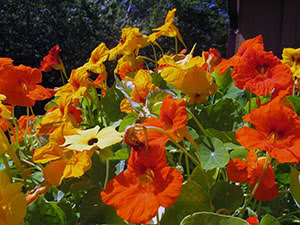 Nasturtium, or tropaeolum, is a herbaceous plant in the family Tropaeolaceae that includes about 90 species. The nasturtium plant comes from South and Central America, but in our climate zone it also settled long ago since it is characterized by unpretentiousness and has good healing properties and great taste qualities. The main thing is that the flower of nasturtium decorates even the most refined garden with its long-lasting flowering. Tropaeolum is derived from a Greek word “tropaion” meaning “trophy”.
Nasturtium, or tropaeolum, is a herbaceous plant in the family Tropaeolaceae that includes about 90 species. The nasturtium plant comes from South and Central America, but in our climate zone it also settled long ago since it is characterized by unpretentiousness and has good healing properties and great taste qualities. The main thing is that the flower of nasturtium decorates even the most refined garden with its long-lasting flowering. Tropaeolum is derived from a Greek word “tropaion” meaning “trophy”.
The flower was named by Carl Linnaeus as plant’s leaves reminded him of shields and its flowers made him think of blood-stained helmets. Nasturtium received its common name because its oil is similar to the oil produced by nasturtium officinale, or watercress.
Nasturtium flower – description
Nasturtiums, both annuals and perennials, are mainly represented by lianas with a juicy stem, and sometimes by semi-shrubs. The leaves are mostly lobed, alternate, entire, palmately parted, or peltate. Its flowers are simple, double and semi-double, of irregular shape, fragrant, irregular, bisexual, axillary, consisting of five (or more) petals with the same amount of sepals, a tube with nectar in the form of a funnel. The color of flowers is mainly red or yellow. The fruit consists of three wrinkled kidney-shaped lobes where round seeds ripen. Both flowers and stems have healing properties and high cooking qualities.
Species and varieties of nasturtium
In the wild nasturtium is perennial, but in our gardens this tropical beauty grows as an annual plant since it cannot tolerate cold winters. The most popular cultivated species are the following:
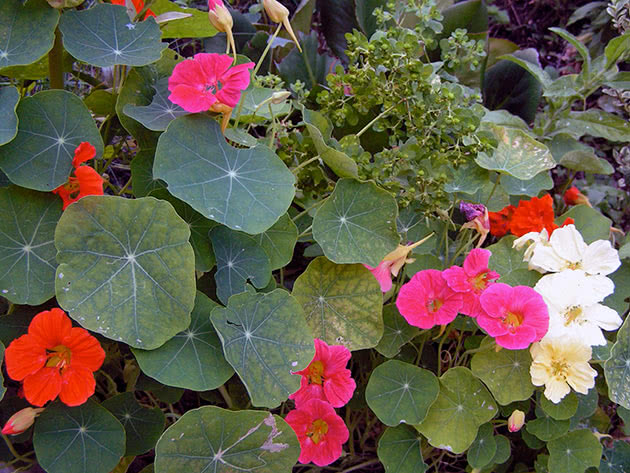
Canary nasturtium
is a liana native to South America. Its light green stems reach 11.4 ft in length and quickly twine around arbors and trellises. It blooms from midsummer till the first frost with bright yellow small flowers with wavy petals and green spurs. The leaves are small, five– or seven-parted. In our climate zone the seeds do not have enough time to ripen.
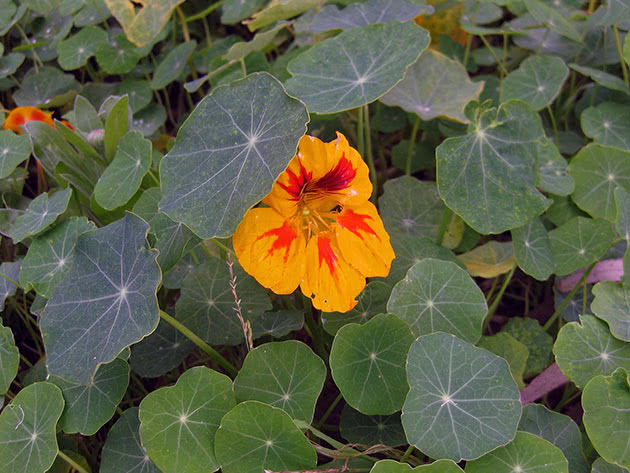
Garden nasturtium
has very branchy, smooth, delicate, 8 ft long stems. If the variety is erect, not trailing, then the stem grows up to 2.3 ft in height. It heavily blooms from June till autumn frosts. It propagates well by self-sowing, the seeds do not lose their germinating capacity up to 4 years. The leaves are asymmetrical, large, roundish, peltate, the upper surface of the leaf is light green, the underside of the leaf is blue-gray, the petioles are long, diameter is about 3 inches. The species is represented by dozens of varieties, including small shrubs:
- King Theodore has bright red flowers;
- Peach Melba’s flowers are cream with red spots in the center;
- Salmon Baby has semi-double salmon flowers;
- Ladybug’s flowers are of apricot hue with burgundy spots in the middle.
Tropaeolum cultorum
combines hybrids of shield nasturtium and garden nasturtium. Its stems are leafy, the color of peltate leaves is green or purple. The varieties of this species differ in shape and height: there are compact varieties of nasturtium (up to 20 inches in height), trailing varieties with a length of shoots up to 13 ft, and dwarf varieties that are 6-8 inches in height. The varieties are:
- Gleaming Mahogany is a shrub up to 14.5 inches tall with double red flowers;
- Golden Globe is a ball-shaped bush up to 10 inches high and 15.7 inches wide with round light green leaves and large (up to 2.5 inches in diameter) double golden-yellow flowers;
- Moonlight is a trailing plant, the stems of which reach 6.5 ft in length, the flowers are pale yellow.

Dwarf nasturtium
has branching, furrowed, thin stems up to 1.1 ft in length. The leaves of dwarf nasturtium are small, rounded, peltate. The petioles are very long and thin. Small flowers are up to 1.1 inches in diameter, of yellow color with dark spots, the three upper velvety petals have pointed edges, the spurs are cylindrical and curved. This species of nasturtium blooms from June to October. The varieties are:
- Cherry Rose grows up to 12 inches in height, blooms with bright red double flowers;
- Black Velvet also grows up to 12 inches in height, its simple flowers are up to 2.3 inches in diameter, the color of flowers is dark burgundy, almost black. Sometimes this variety is called “Black Lady”.
Shield nasturtium
is a trailing semi-shrub with dark green, juicy and fragile shoots that reach 13 ft in length. The leaves are peltate, dark green. The flowers are rich dark red. It blooms from June to October and the seeds have enough time to ripen. The most popular variety is Lucifer. It is upright shrubs with up to 10 inches in height, the shoots are light green, the leaves are large, dark green with a dark red tinge. Red-orange flowers are simple, up to 2.3 inches in diameter.

Other species of nasturtium that differ in ornamentality are blue nasturtium, climbing nasturtium, wreath nasturtium, flame nasturtium, Chilean nasturtium, and others, but, unfortunately, few people can boast about successful experience of growing of these species in our climatic zone.
Growing of nasturtium from seeds
Sowing of nasturtium seeds
Nasturtium propagates by seeds, and even a beginner can cope with it. Large seeds of nasturtium are sown directly into the open ground in the middle or at the end of May, when there are no threats of night frosts. The planting holes should be up to 0.8 inch deep and located at a distance of 10-12 inches from each other. Place 3-4 seed grains into a planting hole. If there is a chance of a night temperature drop, cover the planting site with a plastic wrap or other covering material and use only warm water for irrigation. In a week or two the shoots will appear.

Seedlings of nasturtium
Nasturtium can be propagated by seedlings. In this case nasturtium starts flowering earlier than those plants grown from seeds. To do this, use peat cups or cups with a pull-out bottom. In April-May sow 2-3 seed grains into a cup at a depth of 0.8 inch. The temperature in the room with the seedlings should be 68-72ºF. Seedlings will appear in a couple of weeks. Make sure that the seedlings have enough light, because the lack of light makes them overstretched, and after planting they remain ill for a long time and do not bloom. The root system of nasturtium is weak, and the leaf surface is quite large, so not to damage the roots, the seedlings are not pricked out, but transplanted together with the soil clod directly in the cup.
Planting of nasturtium
When to plant nasturtium
Planting of nasturtium is carried out at the beginning of June. In your garden choose a well-lit and quiet place, since in the shade the nasturtium does not bloom so abundantly as in a good light. The soil should be weakly acidic, with good drainage, light and fertile. If the soil is organic, the plants produce a rich green foliage, but the plants do not bloom. If the soil is too poor, the flowering of nasturtium is not so beautiful, the leaves are small, and the stems look bare. If water stagnates in the soil, nasturtium rots.
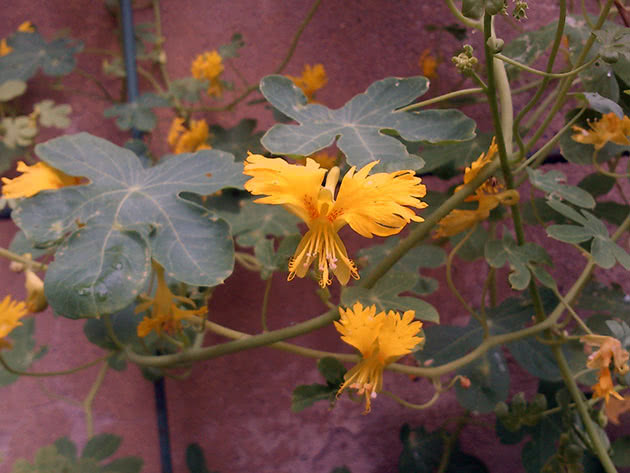
How to plant nasturtium
Seedlings are planted out in June. Planting-out of seedlings is carried out together with a soil clod, and if you sowed seeds in peat pots, then you should plant seedlings right along with the pots to avoid the damage or breakage of fragile rootlets. Depending on the species of nasturtium, the distance between seedlings should be 8-16 inches. First time it is better to cover them at night. Nasturtiums will flower in a month or a month and a half.
Nasturtium: care
How to care for nasturtium
Care for nasturtium implies weeding and watering. If you mulch the site after planting, then there will be no need to fight with weeds. At the very beginning of the growth, regular and abundant watering is very important. When nasturtium starts blooming, it should be watered only when the soil dries up: if the soil is moist all the time, the plant will have a rich foliage, but there will be few flowers. It is necessary to remove withered flowers timely, unless you need seeds. However, for seed collecting you will need only a few ripe seed-buds. Nasturtium is fed with a potassium phosphate fertilizer weekly until its flowering. Nitrogen fertilizers will not be needed.
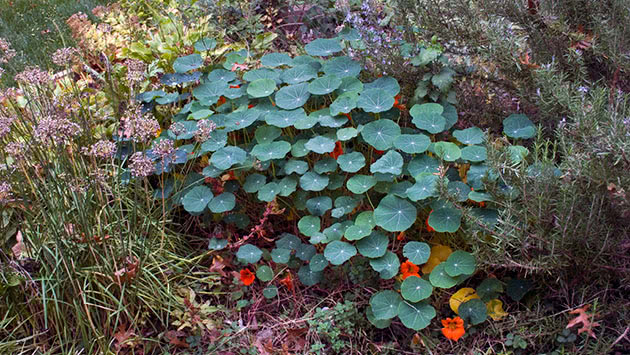
Propagation of nasturtium
In addition to the seed method, a vegetative method of propagation by cuttings is also used. Cuttings are rooted in wet sand or water. This method is mostly used to propagate the species of double or newly bred nasturtiums, the seeds of which are difficult to find in the nurseries. The vegetative method allows to preserve species and varietal characteristics during reproduction.
Pests and diseases of nasturtium
Nasturtium is not only beautiful, but also very useful. In addition, it somehow scares away Colorado potato beetles, whiteflies, aphids, cabbage white butterflies and other insect pests. But still nasturtium can be affected by such disease as alfalfa bacterial wilt the symptoms of which are weakening of the lower leaves, and then withering of the entire plant. One more disease is gray rot that manifests itself by dry brown spots on the leaves. From time to time, brown or black rust spots or mottled mosaic stains appear on the nasturtium leaves. If the plant is affected by these diseases, it must be removed and burned, and healthy plants should be treated with special drugs that destroy the causative agents of the disease.
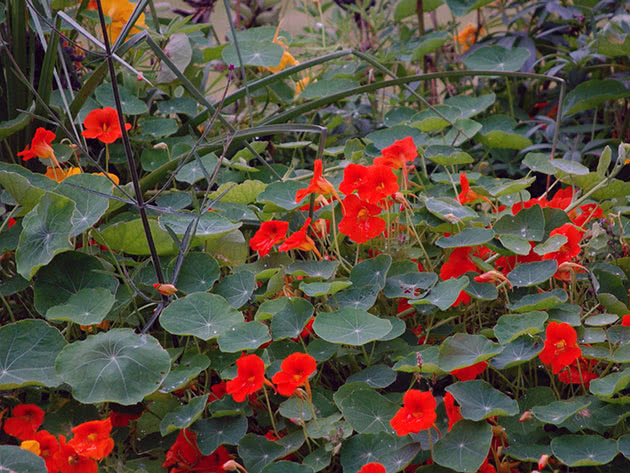
How to collect the seeds of nasturtium
If you want to do breeding, you can collect the seeds of nasturtium by yourself. The seeds ripen as the flowers are fading. It must be noted that the seeds of all species of nasturtium have enough time to mature until frosts, except for Canary nasturtium. When the seeds ripen, they turn from green to whitish and fall to the ground, easily separating from the pedicel. Therefore, be careful and try to collect them before they fall off. Store ripened seeds in the cardboard boxes. Seeds of Canary nasturtium are harvested earlier for them to ripen at home.
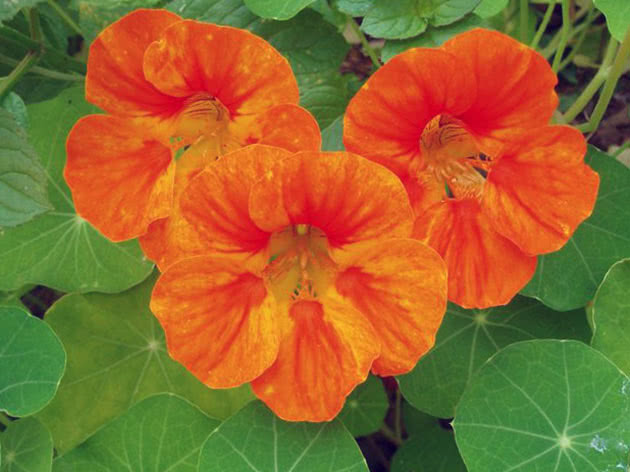
Nasturtium after flowering
After nasturtium has faded, watering is gradually reduced to a complete cessation. Since nasturtium is mainly grown as an annual plant, in autumn it should be treated respectively: collect the seeds (if necessary), burn the plant tops, dig over the site.
Nasturtium: medicinal properties
Nasturtium is not only beautiful, but also edible and medicinal. Leaves and flowers of young plants are used as decoration for dishes and ingredients of salads, sandwiches, soups. Pickled fruits of nasturtium have the taste of expensive capers. And dried and ground seeds can be used as a seasoning instead of black pepper, at least during the Second World War they were used like this. All parts of the plant are edible, except for the roots.

The healing properties of nasturtium have been known for a long time. It treats skin rashes, stimulates hair growth, it helps with anemia, avitaminosis, nephrolithiasis. The plant has proved to be a good remedy to fight with scurvy, since it has ten times more vitamin C than salad does. In addition, nasturtium contains substances that successfully fight with microbes – provitamin A and phytoncides. Nasturtium is a part of the diet for the elderly with metabolic disorders and atherosclerosis. Rhizomes of tuberous nasturtium contain substances that lower the level of testosterone in the blood, which is necessary in certain cases. Modern science has established that nasturtium possesses such valuable properties for medicine as anti-inflammatory, laxative, diuretic, antiseptic, antibiotic, antiscorbutic, uroseptic, expectorant. However, you should know that an overdose of nasturtium medication provokes irritation of the mucosa of the gastrointestinal tract.
